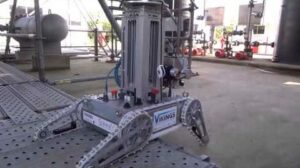 ESIGELEC, an engineering school based in Rouen, France, has announced that its Viking Robot – equipped with Velodyne’s VLP-16 3D real-time LiDAR Puck – has taken first place in the ARGOS Challenge.
ESIGELEC, an engineering school based in Rouen, France, has announced that its Viking Robot – equipped with Velodyne’s VLP-16 3D real-time LiDAR Puck – has taken first place in the ARGOS Challenge.
The ARGOS Challenge is an international robotics competition designed to foster development of a new class of autonomous robots adapted to surveillance and technical maintenance of oil and gas sites.
ESIGELEC’s Team Vikings developed a 6DDL Monte Carlo Localization (MCL) based on VLP-16 measurements, with an absolute position error less than 3cm and an orientation error less than 0.3° at 20Hz. Teams were evaluated on how well each addressed safety requirements, mobility and navigation, data collection, and human machine interface (HMI).
In the first round, the robot had to be able to achieve automatic inspection missions under real conditions. Teams received the script two hours prior to the competition: the robot then needed to pass through control points to read gauges monitoring the state of pressure sensors and to determine whether the floodgates were open or closed. The robot needed to traverse a 20-centimeter-high obstacle in order to automatically climb on or off the platform, and encountered various unexpected obstacles as well. The ESIGELEC Vikings robot was able to perform the first mission on automatic mode in less than four minutes, far quicker than the 20 minutes allotted to the task.
“Clearly, our localization method based on VLP-16 measurements has been a key factor in our success,” said Xavier Savatier, Ph.D., Head of the Instrumentation, IT & Systems Department, ESIGELEC. “What stands out about the VLP-16 are its light weight and size, and its 360° field of view, which helped its integration on the mobile Vikings robot. The sensor’s 3D laser scan strongly reduces the perceptual aliasing problem, which is an issue since there’s so much symmetry in the outdoor site.”
“The ARGOS Challenge dramatically and effectively demonstrates what robots equipped with real time LiDAR sensors can achieve in the demanding oil and gas environment,” said Wolfgang Juchmann, Director of North America Sales and Product Management, Velodyne. “Over the duration of the challenge, robots will attempt vital tasks in simulated offshore or onshore platforms, with total autonomy and under the most extreme conditions. Those are precisely the conditions for which we developed our multi-channel 3D LiDAR sensors.”
In time, robots will be capable of performing inspection tasks, detecting anomalies and intervening in emergency situations. All of the autonomous missions require precise localization, an especially difficult task to perform in an industrial outdoor setting, with pipes in all directions and no walls to define the space.
The ARGOS Challenge research and development process runs for three years and includes three rounds of competition at the test site in Lacq, Midi-Pyrénées, in southern France. The difficulty level will increase during the second round competition in March. At that time, robots will be expected to identify unusual sounds such as gas leaks or cavitation bubbles inside the pipes, and check for unknown obstacles or fire extinguishers. Tests will take place on the upper levels of the structure, requiring robots to ascend and descend flights of stairs.


















